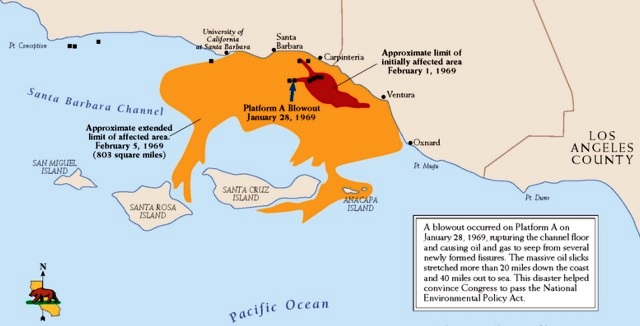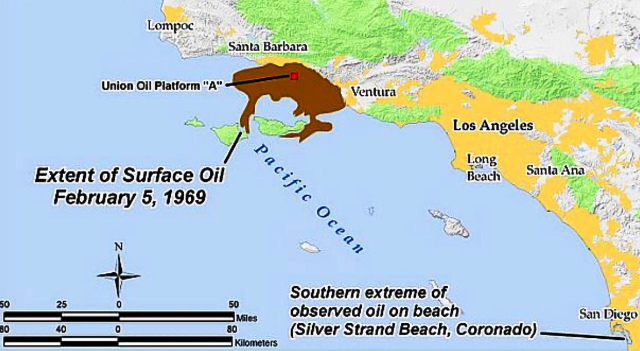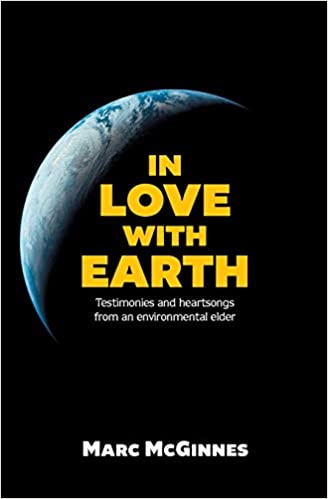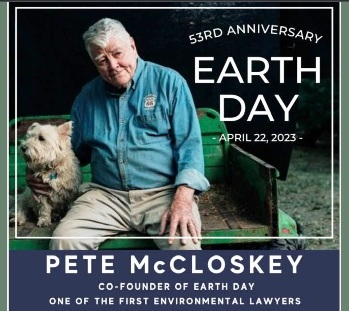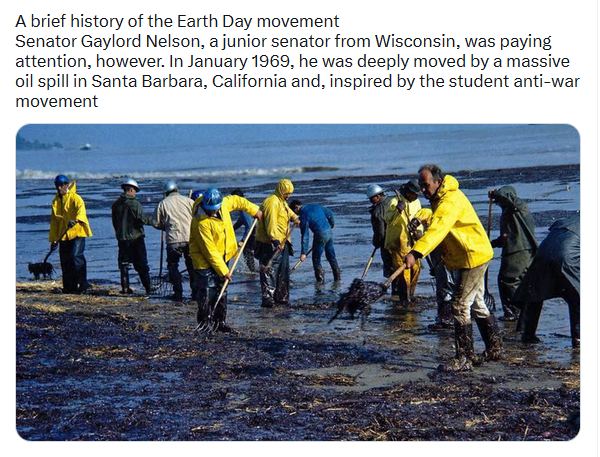File:Union Oil Spill On the Calif Coast - January 1969.png
Union_Oil_Spill_On_the_Calif_Coast_-_January_1969.png (640 × 326 pixels, file size: 196 KB, MIME type: image/png)
The 1969 Santa Barbara oil spill ranks as the third worst U.S. spill, with only the 2010 BP / Deepwater Horizon Gulf of Mexico blowout, and the 1989 Exxon Valdez oil tanker spill off Alaska, ahead of it, ranking respectively as the nation’s No.1 and No. 2 spills.
On January 28th, 1969, an oil well blow-out at Union Oil’s offshore platform in the Santa Barbara Channel six miles off the California coast, began one of the worst oil spills in U.S. history.
At one point, shortly after the blow out, a capping action at the well head on the platform appeared to have staunched the worst of the problem. However, complications down the well shaft due to insufficient well casings led to further problems: oil and gas escaped through the sides of the well bore and at several locations on the seabed floor below the rig. Nearby, on the water’s surface, oil and gas “boil ups” as they were called, could be seen, signaling the bigger problems below.
The worst of the spill would continue for 11 days, with lesser leaks continuing for months thereafter. Sea birds, seals, dolphins, kelp beds, and miles of beaches were coated with black crude. In the end, an estimated 80,000 to 100,000 barrels of oil were spilled and some 30-to-35 miles of California coastline tarred.
As the crude escaped during the blowout and from sub-surface releases it was spread over hundreds of square miles of open water by winds and swells. After a few days at sea, incoming tides brought the thick tar to beaches and towns along Santa Barbara County’s spectacular coastline, including: Goleta, home of University of California at Santa Barbara; the harbor at Santa Barbara; the coastline at Carpinteria; Rincon Point, the famous surfing beach; and Ventura. The farthest effects of the spill extended to Pismo Beach north of Santa Barbara, and south to the Silver Strand Beach at San Diego. Some beaches were spared the worst, as offshore kelp forests kept much of the crude from coming ashore. But a considerable length of California coastline, as well as coves and offshore islands, were hit by the spill. Frenchy’s Cove on Anacapa Island was hit, as well as beaches on Santa Cruz, Santa Rosa, and San Miguel Islands.
“You go to the beach and you couldn’t hear the waves. All the ocean was black. People just stood their crying. We figured it was all over for Santa Barbara.” – Bud Bottoms, co-founder of Get Oil Out.
With the ’69 oil spill, people had this realization that we should protect the environment for the environment’s sake.
This concept of environmental rights emerged. UCSB history professor Rod Nash wrote this declaration of environmental rights and it was presented at this conference that was on the one year anniversary of the spill. He then went on to found the first environmental studies program in the U.S.
More about the 1969 California oil spill/blowout disaster...
A memoir of an era.
By Marc McGinnis, Environmental attorney
Retired University of California, Santa Barbara professor
Publisher Introduction (2018): This memoir by environmental legal pioneer Marc McGinnes chronicles his ongoing work in the environmental movement at its birthplace in Santa Barbara after the devastating 1969 oil blowout. Recounting his involvement in the conference that presented the Santa Barbara Declaration of Environmental Rights, the first Earth Day celebrations, and the creation of enduring institutions such as the Environmental Defense Center, the Community Environmental Council, and the Environmental Studies program at University of California Santa Barbara, this book is a valuable resource for anyone seeking an eyewitness account of the formative days of the environmental movement. It also tells the personal story of the author's deeply spiritual transformation from a hotshot corporate lawyer who routinely represented the rapacious power elite to environmental lawyer, mediator and teacher. Changed forever by a photograph of Earth from space and a call from his powerful mentor in Congress, the trajectory of his life is redirected towards the pursuit of environmental justice. Conversational in tone, this highly readable and inspiring volume is packed with the tales of personal connections, surprising collaborations, leaps of faith, and acts of service that constitute the author's long and successful campaign fighting for the planet he loves.
“There’s a Rep. Pete McCloskey from Washington, D.C, on the line for you.” I put down the recorder, reached for the telephone and heard Pete say, “Marc, have you heard about this oil platform blowout in Santa Barbara?”
“Hi, Pete. Yes, I read some of the news about it.”
“Well, I think you should get down there as quickly as you can and get involved. This is going to open up a whole new field of law. I’m at work right now helping to draft new legislation that will fundamentally change how governmental decisions affecting the environment are made. Young lawyers like you are going to be needed to enforce it in the courts. It’s a National Environmental Policy Act, and we want to be sure that similar state laws are enacted and enforced.”
More on the National Environmental Policy Act here:
Planet Citizens, Planet Scientists, Preserving & Protecting the Home Planet Earth
- From the original NASA Mission Statement: "To understand and protect our home planet"
GreenPolicy360 Siterunner / SJS: What is almost always overlooked when one talks about the first years of the modern environmental movement is the science, the new science of the environmental movement. Most all media from the era of the 60s and 70s seems to have missed what your GreenPolicy360 siterunner was experiencing first hand -- a history of ideas, a shift in paradigms as what is now called "earth science" and "atmospheric science" and "climate change" and "global warming" first came onto the radar.
When one looks at today's Earth Science Research from Space and accumulative science data acquired over the decades, we are seeing the results of a congressman from my home district, a man called George E. Brown. George became my friend and mentor and together for over 30 years we collaborated as George became a visionary leader in the U.S. House of Representative.
Here is a touch of what I've written about George's life -- George E. Brown Jr
Planet Citizen, Planet Citizens, and Planet Citizens, Planet Scientists at GreenPolicy360 are influenced directly by George Brown. As an engineer with a physics background, George knew we were responsible for the next generation. The environmental movement we were launching would need good scientific data to make the decisions guiding how we respond to the great challenges of our times, the existential threats on multiple fronts. Your GreenPolicy360 siterunner has continued to carry this message under under a banner of earth science. Today, our 21st century earth science missions are tapping into the data and scientific results of programs designed to produce the knowledge base George Brown knew would be needed to make wise and even fateful decisions. Whether we make the necessary decisions is up to our generation, every generation has a 'generational responsibility'. We, at GreenPolicy360, see rising challenges all of us must face, as Planet Citizens acting with vision...
GreenPolicy360's founder was fortunate, beginning in the 1960s, to listen to Congressman Brown Congressman George E. Brown point to the NASA planning and explain how he saw Congress put into action the reality of a multi-year, coordinated, multi-agency atmospheric/earth science program to achieve mission goals. Earth science, measuring and monitoring Earth's life-enabling systems was given highest priority. Landsat's program was set in motion as a decades long, first-ever digital scanning remote satellites data collecting study. An array of satellites began to launch, creating and combining the expanding resources of NASA, USGS, NOAA, and an array of educational and scientific institutions and aeronautics business.
The overall goal, Representative Brown would continue to explain in his Congressional Science, Space & Technology leadership roles over the decades, was to understand, preserve and protect our planet as we, humanity, develop the science to look beyond the Earth and study 'the heavens'.
Here's to George Brown and the many visionaries, thinkers and doers who have carried on preserving and protecting our home planet.
As George and I worked with him over many years we both grew in our politics as we worked together for peace and environmental protection. Big science was at the center of much of George's future-looking agenda. He believed in green politics and was a mentor to me and many. He became a leader in Congress from California who helped shape the modern environmental movement.
Today many of the actions of George Brown continue as models for citizens, cities and nations of the world. California and a green political/environmental protection movement that George helped to begin continue to be out in front with ideas to improve quality of life.
In our GreenPolicy360 work, George's work continues. Even as political opposition to environmental work, anti-nuclear work, anti-war work is at risk, as we look out at a strategic horizon with pressing demands, the foundations put in place by an earlier generation remain strong.
Planet Citizen Action | Climate Problems, Climate Solutions
·········································································
"How the First Earth Day Was Born from the 1960s Counterculture" via History.com
(First, a tip of the hat to the meaning of 'counterculture' / 'counter culture' via Wikipedia) - https://en.wikipedia.org/wiki/Counterculture - https://en.wikipedia.org/wiki/The_Making_of_a_Counter_Culture)
Growing Environmental Consciousness
Rachel Carson’s bestselling book Silent Spring, published in 1962, introduced many Americans to the devastating effects of the large-scale use of pesticides, especially DDT.
As the 1960s continued, more and more people became aware of other threats to the environment, such as automobile emissions, oil spills and industrial waste.
By 1967, the federal government had passed the first Clean Air Act, the first federal emissions standards and the first list of endangered species (including the bald eagle, America’s national symbol). These laws were a start, but they did not go far enough to address the serious environmental problems facing the nation.
In January 1969, the Union Oil well in Santa Barbara, California spilled more than 200,000 gallons of oil into the Pacific Ocean over 11 days. That June, oil and chemicals floating on the surface of the Cuyahoga River in Ohio burst into flames. Images of such disasters, broadcast across the country, helped fuel a growing outrage over the state of the environment, especially among young radicals.
Drawing Inspiration from the Anti-War Movement
Despite this growing consciousness, environmental activists hadn’t yet come together as a true movement by the end of the 1960s, as civil rights and anti-war activists had. This lack of momentum had long frustrated Gaylord Nelson, a Democratic senator and former governor of Wisconsin (1959-63) who was one of Congress’ most passionate environmentalists. During his years in the Senate, Nelson had also backed civil rights legislation and voted against appropriating funds for the war in Vietnam.
In August 1969, Nelson traveled to California, where he spoke at a water conference and visited the scene of the Santa Barbara oil spill. On that trip, he was struck by an article he read in Ramparts magazine about the anti-war “teach-ins” held on college campuses in the mid-1960s. Though teach-ins had been abandoned as an anti-war tactic, Nelson now saw their potential to energize people—especially young people—by educating them about the need to protect the environment.
On September 20, 1969, speaking at the annual symposium of the Washington Environmental Council in Seattle, Nelson announced that he was planning a nationwide teach-in on the environment for the following spring. “I am convinced that the same concern the youth of this nation took in changing this nation’s priorities on the war in Vietnam and on civil rights can be shown for the problem of the environment,” he said.
Grassroots Action and Bipartisan Backing
To put his plan into action, Nelson reached across the aisle in Congress, recruiting the Republican congressman Pete McCloskey of California to serve as his co-chair on the steering committee behind the event. Despite his otherwise conservative views, McCloskey was a committed environmentalist who also opposed the Vietnam War. In December 1969, Nelson hired Denis Hayes, the 25-year-old former president of the student body at Stanford University, as national coordinator of the Environmental Teach-In, as Earth Day was originally known. On a tight budget, Hayes recruited a small staff of volunteers, many of them students, to come to Washington, D.C. and coordinate Earth Day events in various regions of the country.
Thanks in large part to these committed young grassroots activists, the first Earth Day took place on April 22, 1970. In New York, 250,000 people flooded Fifth Avenue, after Mayor John Lindsay agreed to bar traffic for two hours between 14th and 59th Streets, all the way up to Central Park. In Miami, supporters of Eugene McCarthy, the anti-war presidential candidate in 1968, staged a parody of the Orange Bowl parade called the “Dead Orange Parade.” As Adam Rome recounted in his book The Genius of Earth Day, one of the parade’s floats featured the Statue of Liberty wearing a gas mask, standing on a pedestal made out of garbage.
·····················································
Lasting Impact of Earth Day
GreenPolicy360: Earth Day itself looks to origins in California, from student activists and members of the US Congress who joined to enlarge the message of a modern environmental movement that came out of a pro-peace movement of student teach-ins...
🌎
File history
Click on a date/time to view the file as it appeared at that time.
| Date/Time | Thumbnail | Dimensions | User | Comment | |
|---|---|---|---|---|---|
| current | 12:48, 2 May 2023 |  | 640 × 326 (196 KB) | Siterunner (talk | contribs) |
You cannot overwrite this file.
File usage
The following 3 pages use this file:
- Anthropocene
- Atmospheric Science
- Biodiversity
- Biosphere
- California
- Citizen Science
- Civil Rights
- Clean Air
- Clean Water
- Climate Change
- Earth
- Eco-ethics
- Eco-nomics
- Eco-Spirituality
- Earth Day
- EOS eco Operating System
- Earth360
- EarthPOV
- Earth Observations
- Earth Science
- Ecofeminism
- Ecology Studies
- Education
- Energy
- Environmental Laws
- Environmental Protection
- Environmental Security
- Environmental Security, National Security
- Food
- Global Security
- Global Warming
- Green Best Practices
- Green Networking
- GreenPolicy360
- Green Graphics
- Green Politics
- Health
- Human Rights
- Money in Politics
- Natural Resources
- Natural Rights
- Nature
- Networking
- New Definitions of National Security
- Overview Effect
- Peace
- Planet Citizen
- Planet Citizens
- Planet Scientist
- Planet Citizens, Planet Scientists
- Renewable Energy
- Resilience
- Seventh Generation Sustainability
- Solar Energy
- Strategic Demands
- Sustainability
- Sustainability Policies
- ThinBlueLayer
- US Environmental Protection Agency
- Water Quality
- Whole Earth
- Wildlife
- Women's Rights
- World Wide Web
- Youth
